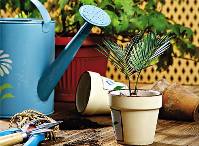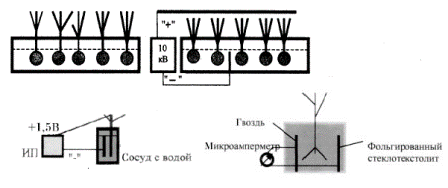Categories: Featured Articles » Interesting Facts
Number of views: 19674
Comments on the article: 0
How plants respond to electricity
 To begin with, the agricultural industry is completely destroyed. What's next? Is it time to collect stones? Is it time to unite all the creative forces to give the villagers and summer residents those new products that will dramatically increase productivity, reduce manual labor, find new ways in genetics ... I would suggest readers of the magazine to be authors of the heading "For the village and summer residents". I will start with the long-standing work "Electric field and productivity."
To begin with, the agricultural industry is completely destroyed. What's next? Is it time to collect stones? Is it time to unite all the creative forces to give the villagers and summer residents those new products that will dramatically increase productivity, reduce manual labor, find new ways in genetics ... I would suggest readers of the magazine to be authors of the heading "For the village and summer residents". I will start with the long-standing work "Electric field and productivity."
In 1954, when I was a student of the Military Academy of Communications in Leningrad, I was passionately carried away by the process of photosynthesis and conducted an interesting test with growing onions on the windowsill. The windows of the room in which I lived were facing north, and therefore the bulbs could not receive the sun. I planted five bulbs in two elongated boxes. He took the earth in the same place for both boxes. I had no fertilizers, i.e. the same conditions for growing were created. Above one box on top, at a distance of half a meter (Fig. 1), I placed a metal plate to which I attached a wire from a high-voltage rectifier + 10 000 V, and a nail was inserted into the ground of this box, to which I connected a “-” wire from the rectifier.
I did this so that, according to my theory of catalysis, the creation of a high potential in the plant zone will lead to an increase in the dipole moment of the molecules involved in the photosynthesis reaction, and the test days are drawn. Within two weeks I discovered that in a box with an electric field, plants develop more efficiently than in a box without a "field"! After 15 years, this experiment was repeated at the institute, when it was required to achieve the cultivation of plants in a spaceship. There, being closed to magnetic and electric fields, plants could not develop. I had to create an artificial electric field, and now plants survive on spaceships. And if you live in a reinforced concrete house, and even on the top floor, do not your plants in the house suffer from the absence of an electric (and magnetic) field? Put a nail into the ground of the flower pot, and connect the wires from it to the heating battery cleaned from paint or rust. In this case, your plant will approach living conditions in open space, which is very important for plants and for humans too!
But my tests did not end there. Living in the city of Kirovograd, I decided to plant tomatoes on the windowsill. However, winter came so fast that I did not have time to dig up tomato bushes in the garden to transplant them into flower pots. I came across a frozen bush with a small living process. I brought him home, put him in the water and ... Oh, joy! After 4 days, white roots grew from the lower part of the process. I transplanted it into a pot, and when it grew with shoots, I began to receive new seedlings in the same way. All winter I enjoyed fresh tomatoes grown on the windowsill. But I was haunted by the question: is it really possible in nature such cloning? Perhaps, old-timers in this city confirmed to me. Perhaps, but ...

I moved to Kiev and tried to get tomato seedlings in the same way. I didn’t succeed. And I realized that in Kirovograd I was successful in this method because there, at the time when I lived, water was pumped into the water supply system from wells, and not from the Dnieper, as in Kiev. Groundwater in Kirovograd has a small fraction of radioactivity. This is what played the role of a root growth stimulator! Then I put +1.5 V from the battery to the top of the tomato shoot, and I brought the vessel where the shoot was to the “-” to the water (Fig. 2), and after 4 days a thick “beard” grew on the shoot in the water! So I managed to clone the shoots of a tomato.
Recently, I was tired of watching the watering of plants on the windowsill, I put a strip of foil fiberglass and a large nail in the ground. I connected the wires from the microammeter to them (Fig. 3). The arrow immediately diverged, because the earth in the pot was damp, and a copper-iron galvanic pair worked. A week later, I saw how the current began to fall. So, it was time to water ... In addition, the plant threw new leaves! This is how plants react to electricity.
See also at bgv.electricianexp.com
:
